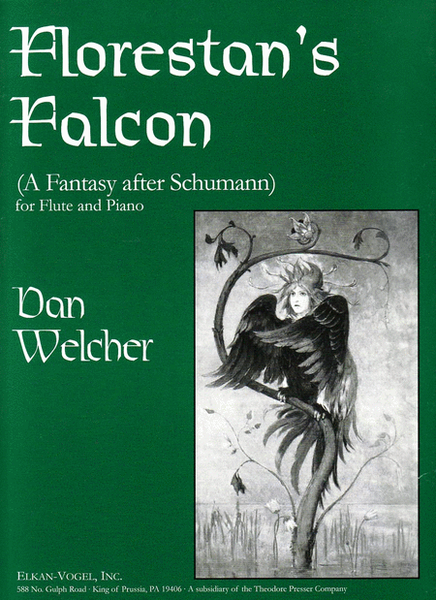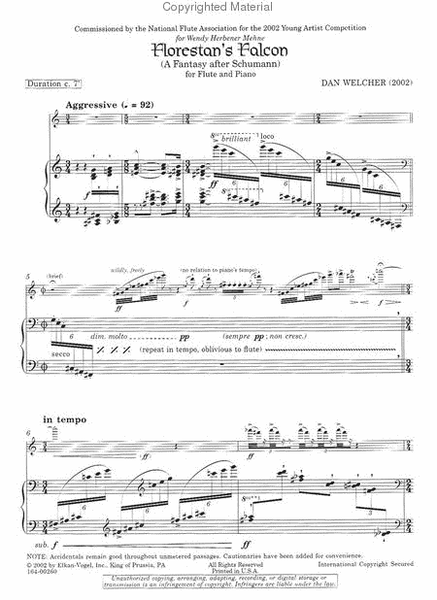Florestan's Falcon
A Fantasy After Schumann, for Flute and Piano
-
Ships in 1 to 2 weeks
Details
Description
SKU: PR.164002600
A Fantasy After Schumann, for Flute and Piano. Composed by Dan Welcher. Set of Score and Parts. With Standard notation. Composed 2002. Duration 7 minutes. Theodore Presser Company #164-00260. Published by Theodore Presser Company (PR.164002600).UPC: 680160038381.
Where would classical music be without its mad geniuses? Robert Schumann, known by too many music lovers as the composer of The Happy Farmer, was in fact one of the most revolutionary and forward-looking composers of the mid-nineteenth century. His writing for the piano shows his entire range: technical, emotional, and aesthetic. He spoke of his own duality, of the clash between intellect and emotion, by claiming two distinct musical personalities. Florestan was the Romantic (with feeling being paramount), and Eusebius the cool Classicist, ruled entirely by the intellect. Works like Carnaval are full of characters, many based on actual people in Schumann's life, and many are attributed to either Florestan or Eusebius. Nervous and intense from the beginning, poor Schumann ended his days in an asylum. Unable to write or even to speak to his wife, he complained of hearing a single pitch constantly in his head. In writing this work for flute and piano, I have taken one of my favorite short works for piano and turned it inside out. A work of Schumann's middle period, Waldszenen (Forest Scenes) contains a mystical and haunting little piece called Vogel als Prophet, which is usually translated as the Prophet Bird. Set in a mournful G minor, it is an A-B-A construction. The first theme, a lilting arpeggiated tune with many wrong notes on strong beats, is in itself very compelling and eerily beautiful. But the middle section is where the magic really occurs: suddenly the flats melt away, and in a pure G Major, the little sad bird leads us into church. This chordal music has a resemblance to the Thanksgiving hymn For The Beauty Of The Earth, and it erases all the doubts and insecurities of the opening theme in a mere six bars. But the ongoing sadness will not leave, and the piece ends in an unsettled, profoundly melancholy G minor. Just what the bird is prophesying we can never know. In Florestan's Falcon, I've allowed Schumann's prophetic bird to have its head. The solo flute is, of course, a personification of the creature; but it is Florestan's bird, and must contend with serious and even frightening visions. Beginning with a wild double-cadenza for flute and piano, the piece eventually settles into a disturbing rhythmic section, with the flute's pecking birdcalls interrupting the piano's brooding song. When, in the middle of the piece, Schumann's G-minor tune appears in relatively simple clothing, the flute is allowed to sing briefly, as the bird finds a brief respite from its anguish. But, with the recurring, incessant sounding of a single note (A), the madness begins to return. The opening music is heard again, wilder and higher, and at the end of the piece when the piano attempts to open the heavens and admit the sunshine; the flute can only peck out its little forest call. The work ends as quizzically as Schumann's little gem of a piece. Florestan's Falcon was commissioned by the National Flute Association for its Young Artist Competition, held in August 2002 at the NFA's annual convention. It is dedicated to my dear friend, the gifted flutist Wendy Herbener Mehne.


 Share
Share